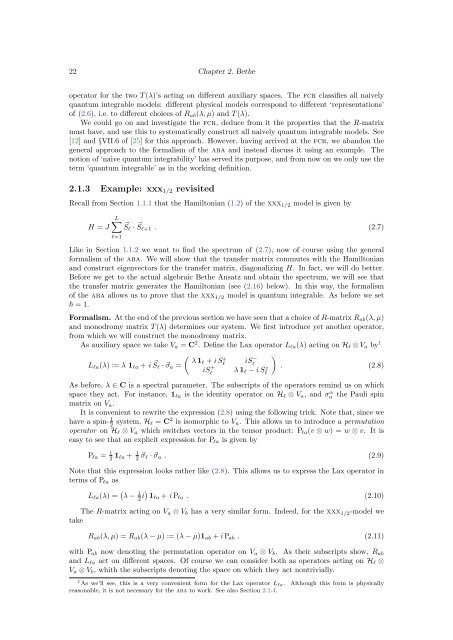The Bethe/Gauge Correspondence
The Bethe/Gauge Correspondence
The Bethe/Gauge Correspondence
Create successful ePaper yourself
Turn your PDF publications into a flip-book with our unique Google optimized e-Paper software.
22 Chapter 2. <strong>Bethe</strong>operator for the two T (λ)’s acting on different auxiliary spaces. <strong>The</strong> fcr classifies all naivelyquantum integrable models: different physical models correspond to different ‘representations’of (2.6), i.e. to different choices of R ab (λ, µ) and T (λ).We could go on and investigate the fcr, deduce from it the properties that the R-matrixmust have, and use this to systematically construct all naively quantum integrable models. See[12] and §VII.6 of [25] for this approach. However, having arrived at the fcr, we abandon thegeneral approach to the formalism of the aba and instead discuss it using an example. <strong>The</strong>notion of ‘naive quantum integrability’ has served its purpose, and from now on we only use theterm ‘quantum integrable’ as in the working definition.2.1.3 Example: xxx 1/2 revisitedRecall from Section 1.1.1 that the Hamiltonian (1.2) of the xxx 1/2 model is given byH = JL∑⃗S l · ⃗S l+1 . (2.7)l=1Like in Section 1.1.2 we want to find the spectrum of (2.7), now of course using the generalformalism of the aba. We will show that the transfer matrix commutes with the Hamiltonianand construct eigenvectors for the transfer matrix, diagonalizing H. In fact, we will do better.Before we get to the actual algebraic <strong>Bethe</strong> Ansatz and obtain the spectrum, we will see thatthe transfer matrix generates the Hamiltonian (see (2.16) below). In this way, the formalismof the aba allows us to prove that the xxx 1/2 model is quantum integrable. As before we set = 1.Formalism. At the end of the previous section we have seen that a choice of R-matrix R ab (λ, µ)and monodromy matrix T (λ) determines our system. We first introduce yet another operator,from which we will construct the monodromy matrix.As auxiliary space we take V a = C 2 . Define the Lax operator L la (λ) acting on H l ⊗ V a by 1(L la (λ) := λ 1 la + i S ⃗ λ 1l + i Sl · ⃗σ a =l z iS − liS + lλ 1 l − i Slz). (2.8)As before, λ ∈ C is a spectral parameter. <strong>The</strong> subscripts of the operators remind us on whichspace they act. For instance, 1 la is the identity operator on H l ⊗ V a , and σaα the Pauli spinmatrix on V a .It is convenient to rewrite the expression (2.8) using the following trick. Note that, since wehave a spin- 1 2 system, H l = C 2 is isomorphic to V a . This allows us to introduce a permutationoperator on H l ⊗ V a which switches vectors in the tensor product: P la (v ⊗ w) = w ⊗ v. It iseasy to see that an explicit expression for P la is given byP la = 1 2 1 la + 1 2 ⃗σ l · ⃗σ a . (2.9)Note that this expression looks rather like (2.8). This allows us to express the Lax operator interms of P la asL la (λ) = ( λ − 1 2 i) 1 la + i P la . (2.10)<strong>The</strong> R-matrix acting on V a ⊗ V b has a very similar form. Indeed, for the xxx 1/2 -model wetakeR ab (λ, µ) = R ab (λ − µ) := (λ − µ)1 ab + i P ab . (2.11)with P ab now denoting the permutation operator on V a ⊗ V b . As their subscripts show, R aband L la act on different spaces. Of course we can consider both as operators acting on H l ⊗V a ⊗ V b , whith the subscripts denoting the space on which they act nontrivially.1 As we’ll see, this is a very convenient form for the Lax operator L la . Although this form is physicallyreasonable, it is not necessary for the aba to work. See also Section 2.1.4.
















